The Stuffed and Plush Toy Market is estimated to be valued at USD 11.3 billion in 2025 and is projected to reach USD 22.9 billion by 2035, registering a compound annual growth rate (CAGR) of 7.3% over the forecast period.
The stuffed and plush toy market is expanding steadily due to increasing demand for comfort-driven play products, evolving consumer preferences, and the influence of character licensing in children’s entertainment. Market growth is being supported by rising disposable income levels, gifting trends, and the growing popularity of themed and collectible plush toys. Manufacturers are focusing on product differentiation, softness, and safety compliance to enhance consumer trust and strengthen brand positioning.
The current landscape is also shaped by sustainability initiatives, where the use of eco-friendly materials and ethical manufacturing practices is gaining prominence. Online retail penetration and digital marketing strategies are further driving market accessibility and brand visibility.
The future outlook remains positive, with innovation in design and materials expected to stimulate new product introductions Long-term growth rationale rests on the combination of emotional appeal, continuous product innovation, and expanding distribution networks that ensure broad market reach and sustained consumer engagement across age groups.
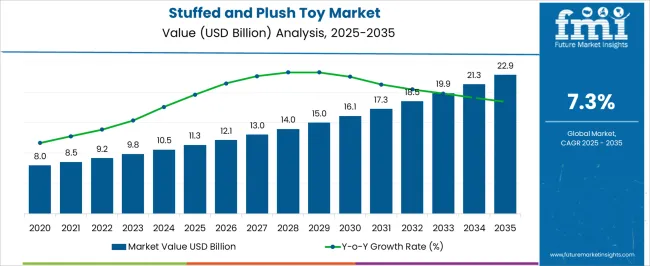
| Metric | Value |
|---|---|
| Stuffed and Plush Toy Market Estimated Value in (2025 E) | USD 11.3 billion |
| Stuffed and Plush Toy Market Forecast Value in (2035 F) | USD 22.9 billion |
| Forecast CAGR (2025 to 2035) | 7.3% |
The market is segmented by Product Type, Material Type, Price Range, and Sales Channel and region. By Product Type, the market is divided into Traditional Stuffed Animals, Cartoon Toys, Battery Operated, Action Figures And Model Play, Dolls and Playsets, Customizable Stuffed Animals, Special Feature Plush Toys, and Puppets. In terms of Material Type, the market is classified into Synthetic, Natural/Organic, and Blended Material. Based on Price Range, the market is segmented into Medium, Low, and High. By Sales Channel, the market is divided into Online Retailers, Hypermarkets/Supermarkets, Multi-Brand Stores, Exclusive Stores, Hobby And Craft Stores, and Other Sales Channels. Regionally, the market is classified into North America, Latin America, Western Europe, Eastern Europe, Balkan & Baltic Countries, Russia & Belarus, Central Asia, East Asia, South Asia & Pacific, and the Middle East & Africa.
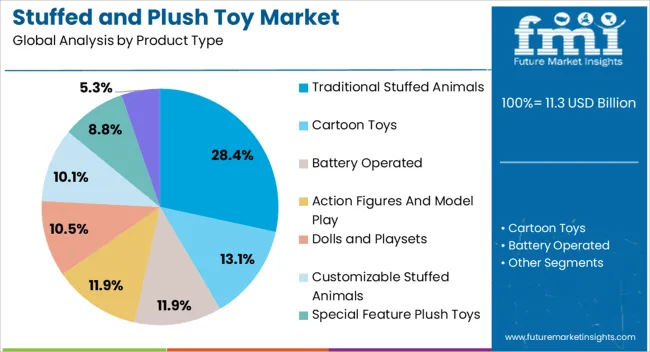
The traditional stuffed animals segment, accounting for 28.40% of the product type category, continues to dominate due to its nostalgic value and enduring appeal among children and adults alike. The segment’s strong presence is being maintained through consistent product innovation and diversification of character themes, which enhance gifting and collectible appeal. Production scalability, coupled with safety certification and adherence to quality standards, has reinforced consumer confidence.
The segment benefits from both retail and online distribution, ensuring wide accessibility. Demand resilience is further strengthened by cultural and emotional associations with classic plush designs.
Manufacturers are leveraging advanced sewing technologies and soft fabric materials to improve tactile quality and durability Over the forecast period, ongoing modernization of traditional toy aesthetics and increased collaboration with entertainment franchises are expected to sustain the segment’s leadership in the global market.
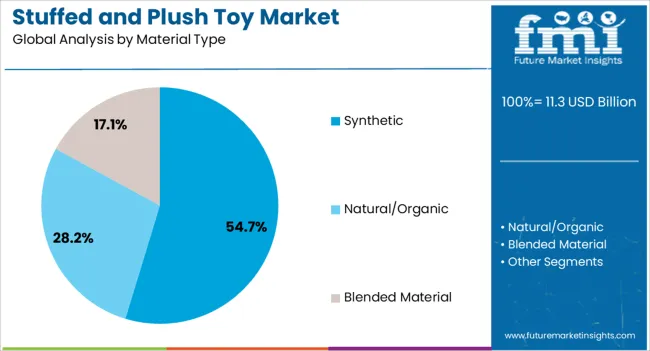
The synthetic material segment, holding 54.70% of the material type category, has remained dominant due to its cost-effectiveness, durability, and flexibility in achieving diverse textures and finishes. Synthetic fibers are preferred by manufacturers for their consistency, ease of coloring, and suitability for mass production.
Their widespread availability and lower production cost have enabled companies to maintain competitive pricing while meeting global demand. Enhanced manufacturing processes have improved softness and safety compliance, addressing both consumer expectations and regulatory standards.
Although sustainable materials are emerging, synthetic options continue to lead because of their superior customization and scalability Continuous advancements in fiber technology and blending techniques are expected to enhance tactile quality and sustainability profiles, ensuring that synthetic materials retain a substantial market share over the coming years.
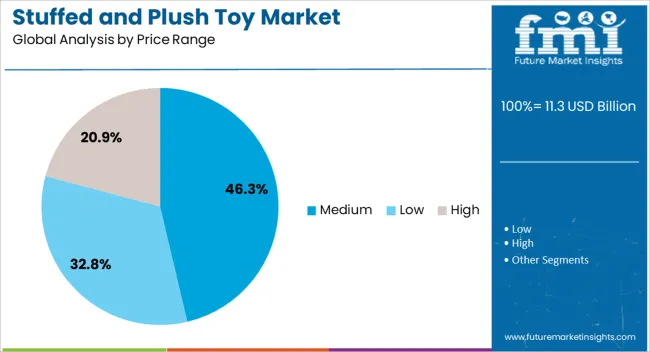
The medium price range segment, representing 46.30% of the price range category, has been leading the market as it balances affordability and quality, appealing to a wide consumer base. This segment captures demand from both mass-market and premium consumers seeking value without compromising on design or safety.
Manufacturers targeting this range benefit from economies of scale, streamlined production, and optimized distribution channels. The availability of diverse designs, branded collaborations, and seasonal collections within this price band has reinforced consistent sales performance.
Retailers and e-commerce platforms favor this segment due to its high turnover and repeat purchase potential Sustained consumer trust, coupled with strategic promotional campaigns, is expected to maintain the dominance of the medium price range segment and support steady market expansion across both developed and emerging economies.
| Leading Product Type | Cartoon Toys |
|---|---|
| Value Share (2025) | 19.80% |
Based on product type, the cartoon toys segment is projected to acquire a market share of 19.80% in 2025. The segment is driven by the following factors:
| Leading Material | Synthetic Material |
|---|---|
| Value Share (2025) | 45.70% |
The synthetic material is significantly used to make stuffed and plush toys. In 2025, the synthetic material segment is projected to acquire a value share of 45.70%. Leading growing factors are:
| Countries | Forecast CAGR (2025 to 2035) |
|---|---|
| The United States | 4.20% |
| Spain | 5.80% |
| China | 9.20% |
| India | 11.10% |
| Japan | 6.90% |
According to the latest market research conducted by FMI analysts, the India stuffed and plush toy market is projected to pace at a CAGR of 11.1% through 2035. The market is also anticipated to acquire a sizeable share of the Asia Pacific region. Key factors that are contributing to market growth are:
The United States stuffed and plush toy industry is estimated to expand at a CAGR of 4.2% through 2035. This regional market holds a prominent place in North America. Salient factors that impact the market dynamics are:
The stuffed and plush toy industry in Japan is expected to propel at a CAGR of 6.9% from 2025 to 2035. Over the forecast period, the market is anticipated to be catalyzed by:
The Spain stuffed and plush toy industry is driven by a CAGR of 5.8% over the next 10 years. Top factors that are propelling the market expansion are:
The China stuffed and plush toy market is accelerating at a CAGR of 9.2% through 2035. Key factors that are catapulting the products’ sales are:
Brands are attempting to cozy up to consumers with the new offerings of these plushies. For instance, MGA Entertainment, which is a creator of Bratz launched Fluffie Stuffiez, a line of ultra-fluffy and huggable toys that come in multiple shapes. Ty also upgraded its iconic Beanie Babies to be softer with the new fabric.
Key players are launching sensational videos or campaigns on social media to increase their popularity and sales. For instance, Squishmallows and Jellycat are having a moment on TikTok with their relevant hashtags amassing 6.3 billion and 873.2 million views. Such popularity is making them the top-selling toys in the market.
The success of stuffed and plush toys is being catalyzed by an important new category of toy purchasers, i.e., adults. Increasing sales from “kidults” who purchase toys motivated by childhood nostalgia. Additionally, surging cases of loneliness, anxiety, and sensory issues are catapulting the sales of soft and cuddly objects that can offer moments of comfort.
Latest Developments in the Stuffed and Plush Toy Market
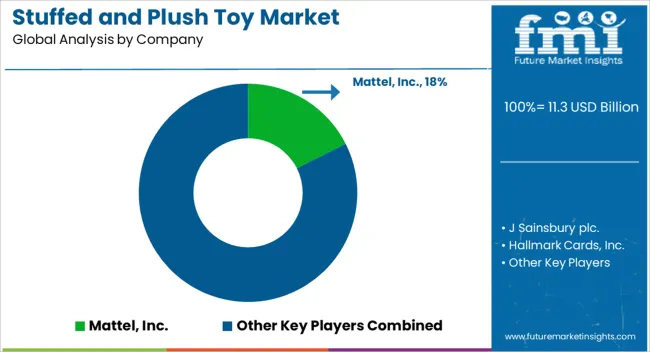
The global stuffed and plush toy market is estimated to be valued at USD 11.3 billion in 2025.
The market size for the stuffed and plush toy market is projected to reach USD 22.9 billion by 2035.
The stuffed and plush toy market is expected to grow at a 7.3% CAGR between 2025 and 2035.
The key product types in stuffed and plush toy market are traditional stuffed animals, cartoon toys, battery operated, action figures and model play, dolls and playsets, customizable stuffed animals, special feature plush toys and puppets.
In terms of material type, synthetic segment to command 54.7% share in the stuffed and plush toy market in 2025.






Full Research Suite comprises of:
Market outlook & trends analysis
Interviews & case studies
Strategic recommendations
Vendor profiles & capabilities analysis
5-year forecasts
8 regions and 60+ country-level data splits
Market segment data splits
12 months of continuous data updates
DELIVERED AS:
PDF EXCEL ONLINE
Microwaveable Stuffed Animal Toys Market Size and Share Forecast Outlook 2025 to 2035
Android Automotive OS (AAOS) Market Size and Share Forecast Outlook 2025 to 2035
Anderson Cascade Impactor Market Size and Share Forecast Outlook 2025 to 2035
Andersen-Tawil Syndrome Treatment Market Trends - Growth & Future Prospects 2025 to 2035
Andro Supplements Market
Hand Towel Automatic Folding Machine Market Size and Share Forecast Outlook 2025 to 2035
Handheld Ultrasound Scanner Market Size and Share Forecast Outlook 2025 to 2035
Handheld Tagging Gun Market Forecast and Outlook 2025 to 2035
Handheld Imaging Systems Market Size and Share Forecast Outlook 2025 to 2035
Sandwich Panel System Market Size and Share Forecast Outlook 2025 to 2035
Hand Tools Market Size and Share Forecast Outlook 2025 to 2035
Land Survey Equipment Market Size and Share Forecast Outlook 2025 to 2035
Handloom Product Market Size and Share Forecast Outlook 2025 to 2035
Band File Sander Belts Market Size and Share Forecast Outlook 2025 to 2035
Handheld XRF Analyzers Market Size and Share Forecast Outlook 2025 to 2035
Sand Abrasion Tester Market Size and Share Forecast Outlook 2025 to 2035
Sand Testing Equipments Market Size and Share Forecast Outlook 2025 to 2035
Landscape Lighting Market Size and Share Forecast Outlook 2025 to 2035
Handheld Police Radar Guns Market Size and Share Forecast Outlook 2025 to 2035
Handheld DNA Reader Market Size and Share Forecast Outlook 2025 to 2035

Thank you!
You will receive an email from our Business Development Manager. Please be sure to check your SPAM/JUNK folder too.
Chat With
MaRIA